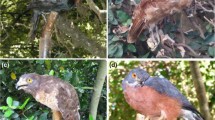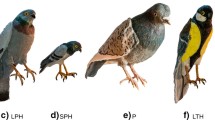Abstract
We compared the responses of the nesting red-backed shrikes (Lanius collurio) to three dummies of a common nest predator, the Eurasian jay (Garrulus glandarius), each made from a different material (stuffed, plush, and silicone). The shrikes performed defensive behaviour including attacks on all three dummies. Nevertheless, the number of attacks significantly decreased from the stuffed dummy through the plush dummy and finally to the silicone dummy. Our results show that wild birds use not only colours but also other surface features as important cues for recognition and categorization of other bird species. Moreover, the silicone dummy was attacked only when presented after the stuffed or plush dummy. Thus, we concluded that the shrikes recognized the jay only the stuffed (with feathered surface) and plush (with hairy surface) dummies during the first encounter. Recognition of the silicon dummy (with glossy surface) was facilitated by previous encounters with the more accurate model. This process resembles the effect of perceptual priming, which is widely described in the literature on humans.




Similar content being viewed by others
References
Arroyo B, Mougeot F, Bretagnolle V (2001) Colonial breeding and nest defence in Montagu’s harrier (Circus pygargus). Behav Ecol Sociobiol 50:109–115. doi:10.1007/s002650100342
Aust U, Huber L (2002) Target-defining features in a “people-present/people-absent” discrimination task by pigeons. Anim Learn Behav 30:165–176. doi:10.3758/BF03192918
Aust U, Huber L (2006) Picture-object recognition in pigeons: evidence of representational insight in a visual categorization task using a complementary information procedure. J Exp Psychol Anim B 32:190–195. doi:10.1037/0097-7403.32.2.190
Aust U, Huber L (2010) The role of skin-related information in pigeons’ categorization and recognition of humans in pictures. Vision Res 50:1941–1948. doi:10.1016/j.visres.2010.07.012
Basile BM, Hampton RR (2013) Monkeys show recognition without priming in a classification task. Behav Process 93:50–61. doi:10.1016/j.beproc.2012.08.005
Blough PM (1989) Attentional priming and visual search in pigeons. J Exp Psychol Anim B 15:358–365. doi:10.1037/0097-7403.15.4.358
Blough PM (1991) Selective attention and search images in pigeons. J Exp Psychol Anim B 17:292–298. doi:10.1037/0097-7403.17.3.292
Blough PM (1992) Detectability and choice during visual search: joint effects of sequential priming and discriminability. Anim Learn Behav 20:293–300. doi:10.3758/BF03213383
Blumstein DT (2006) The multipredator hypothesis and the evolutionary persistence of antipredator behaviour. Ethology 112:209–217
Bovet D, Vauclair J (2000) Picture recognition in animals and humans. Behav Brain Res 109:143–165. doi:10.1016/S0166-4328(00)00146-7
Brodbeck DR (1997) Picture fragment completion: priming in the pigeon. J Exp Psychol Anim B 23:461–468
Brown GE, Ferrari MCO, Malka PH, Russo S, Tressider M, Chivers DP (2011) Generalization of predators and non-predators by juvenile rainbow trout: learning what is and what is not a threat. Anim Behav 81:1249–1256
Buitron D (1983) Variability in the responses of black-billed magpies to natural predators. Behaviour 87:209–236
Caro TM (2005) Antipredator defenses in birds and mammals. University of Chicago Press, Chicago
Clemmons JR, Lambrechts MM (1992) The waving display and other nest site antipredatory behaviour of the black-capped chickadee. Wilson Bull 104:749–756
Cook RG (1992a) Dimensional organization and texture discrimination in pigeons. J Exp Psychol-Anim Behav Proc 18:354–363
Cook RG (1992b) Acquisition and transfer of visual texture discriminations in pigeons. J Exp Psychol-Anim Behav Proc 18:341–353
Cook RG (1993) The experimental analysis of cognition in animals. Psychol Sci 4:174–178
Cook RG, Cavoto KK, Cavoto BR (1995) Same-different texture discrimination and concept learning by pigeons. J Exp Psychol-Anim Behav Proc 21:253–260
Cook RG, Cavoto KK, Cavoto BR (1996) Mechanisms of multidimensional grouping, fusion and search in avian texture discrimination. Anim Learn Behav 24:150–167
Cook RG, Cavoto BR, Katz JS, Cavoto KK (1997) Pigeon perception and discrimination of rapidly changing texture stimuli. J Exp Psychol-Anim Behav Proc 23:390–400
Curio E, Klump G, Regelmann K (1983) An anti-predator response in the great tit (Parus major)—is it tuned to predator risk. Oecologia 60:83–88
Deppe C, Holt D, Tewksbury J, Broberg L, Petersen J, Wood K (2003) Effect of Northern Pygmy-Owl (Glaucidium gnoma) eyespots on avian mobbing. Auk 120:765–771
Dittrich W, Gilbert F, Green P, McGregor P, Grewcock D (1993) Imperfect Mimicry—a Pigeons Perspective. P Roy Soc Lond B Bio 251:195–200
Dukas R (1998) Cognitive ecology: the evolutionary ecology of information processing and decision making. University of Chicago Press, Chicago
Dukas R, Kamil AC (2001) Limited attention: the constraint underlying search image. Behav Ecol 12:192–199. doi:10.1093/beheco/12.2.192
Edmunds M (1974) Defence in animals: a survey of anti-predator defences. Longman, New York
Ferrari MCO, Gonzalo A, Messier F, Chivers DP (2007) Generalization of learned predator recognition: an experimental test and framework for future studies. Proc Roy Soc B 274:1853–1859. doi:10.1098/rspb.2007.0297
Ferrari MCO, Brown GE, Messier F, Chivers DP (2009) Threat-sensitive generalization of predator recognition by larval amphibians. Behav Ecol Sociobiol 63:1369–1375. doi:10.1007/s00265-009-0779-5
Friedman A, Spetch ML, Lank I (2003) An automated apparatus for presenting depth-rotated three-dimensional objects in human and animal object recognition research. Behav Res Meth Ins C 35:343–349. doi:10.3758/BF03202563
Griffin AS, Evans CS, Blumstein DT (2001) Learning specificity in acquired predator recognition. Anim Behav 62:577–589. doi:10.1006/anbe.2001.1781
Hart NS, Partridge JC, Cuthill IC, Bennett ATD (2000) Visual pigments, oil droplets, ocular media and cone photoreceptor distribution in two species of passerine bird: the blue tit (Parus caeruleus) and the blackbird (Turdus merula). J Comp Physiol A 186:375–387
Hartley P (1950) An experimental analysis of interspecific recognition. Symp Soc Exp Biol 4:313–336
Jacobsen OW, Ugelvik M (1992) Antipredator behaviour of breeding Eurasian wigeon. J Field Ornit 63:324–330
Jitsumori M, Delius JD (2001) Object recognition and object categorization in animals. In: Matsuzawa T (ed) Primate origins of human cognition and behavior. Springer, Tokyo, pp 269–293
Katz JS, Cook RG (2000) Stimulus repetition effects on texture-based visual search by pigeon. J Exp Psychol Anim Behav Process 26:220–236
Kelly DM, Cook RG (2003) Differential effects of visual context on pattern discrimination by pigeons (Columba livia) and humans (Homo sapiens). J Comp Psychol 117:200–208
Kleindorfer S, Fessl B, Hoi H (2005) Avian nest defence behaviour: assessment in relation to predator distance and type, and nest height. Anim Behav 69:307–313
Knight R, Temple S (1988) Nest-defense behavior in the red-winged blackbird. Condor 90:193–200
Krätzig H (1940) Untersuchungen zur Lebensweise des Moorschneehuhns, Lagopus l. Lagopus, während der Jugendentwicklung. Jour für Ornith 88:139–166
Kullberg C, Lind J (2002) An experimental study of predator recognition in great tit fledglings. Ethology 108:429–441
Lack D (1965) The life of the robin. Collins, London
Langley CM, Riley DA, Bond AB, Goel N (1996) Visual search for natural grains in pigeons (Columba livia): search images and selective attention. J Exp Psychol Anim Behav 22:139–151. doi:10.1037/0097-7403.22.2.139
Lombardi CM, Curio E (1985) Social facilitation of mobbing in the zebra finch Taeniopygia guttata. Bird Behav 6:34–40
Lorenz K (1940) Vergleichende Verhaltensforschung. Verh deutsch Zool Gesellsch 1939: 69–102
Maia R, Eliason CM, Bitton PP, Doucet SM, Shawkey MD (2013) pavo: an R Package for the analysis, visualization and organization of spectral data. Methods Ecol Evol 4:906–913. doi:10.1111/2041-210X.12069
Němec M, Fuchs R (2014) Nest defense of the red-backed shrike Lanius collurio against five corvid species. Acta Ethol 1–6. doi:10.1007/s10211-013-0175-z
Nicholls E, Ryan CME, Bryant CML, Lea SEG (2011) Labeling and family resemblance in the discrimination of polymorphous categories by pigeons. Anim Cogn 14:21–34. doi:10.1007/s10071-010-0339-4
Patterson TL, Petrinovich L, James DK (1980) Reproductive value and appropriateness of response to predators by white-crowned sparrows. Behav Ecol Sociobiol 7:227–231
Pinheiro J, Bates D, DebRoy S et al (2012) nlme: linear and nonlinear mixed effects models. R package version 3.1-103
R Development Core Team (2012) R: a language and environment for statistical computing. R Foundation for Statistical Computing, Vienna
Rytkönen S, Soppela M (1995) Vicinity of sparrowhawk nest affects willow tit nest defense. Condor 97:1074–1078
Shettleworth SJ (1993) Where is the comparison in comparative cognition? Alternative research programs. Psychol Sci 4:179–184. doi:10.1111/j.1467-9280.1993.tb00484.x
Shettleworth SJ (2010) Cognition, evolution, and behavior, 2nd edn. Oxford University Press, New York
Siddiqi A, Cronin TW, Loew ER, Vorobyev M, Summers K (2004) Interspecific and intraspecific views of color signals in the strawberry poison frog Dendrobates pumillo. J Exp Biol 207:2471–2485
Spetch ML, Friedman A (2006) Comparative cognition of object recognition. Comp Cogn Behav Rev 1:12–35
Stankowich T, Coss RG (2007) The re-emergence of felid camouflage with the decay of predator recognition in deer under relaxed selection. Proc Roy Soc B 274:175–182. doi:10.1098/rspb.2006.3716
Strnad M, Němec M, Veselý P, Fuchs R (2012) Red-backed Shrikes (Lanius collurio) adjust the mobbing intensity, but not mobbing frequency, by assessing the potential threat to themselves from different predators. Ornis Fennica 89:206–215
Tinbergen N (1948) Social releasers and the experimental method required for their study. Wilson Bull 60:6–51
Troje NF, Huber L, Loidolt M et al (1999) Categorical learning in pigeons: the role of texture and shape in complex static stimuli. Vision Res 39:353–366. doi:10.1016/S0042-6989(98)00153-9
Tryjanowski P, Goławski A (2004) Sex differences in nest defence by the red-backed shrike Lanius collurio : effects of offspring age, brood size, and stage of breeding season. J Ethol 22:13–16. doi:10.1007/s10164-003-0096-9
Tryjanowski P, Karg K, Karg J (2003) Assessing Red-backed Shrike Lanius collurio diet: a comparison of collar, pellet and prey remain methods of analysis. Acta Ornithol 38:59–64
Tulving E, Schacter DL (1990) Priming and human memory systems. Science 247:301–306. doi:10.1126/science.2296719
Tvardíková K, Fuchs R (2010) Tits use amodal completion in predator recognition: a field experiment. Anim Cogn 13:609–615. doi:10.1007/s10071-010-0311-3
Tvardíková K, Fuchs R (2011) Do birds behave according to dynamic risk assessment theory? A feeder experiment. Behav Ecol Sociobiol 65:727–733. doi:10.1007/s00265-010-1075-0
Tvardíková K, Fuchs R (2012) Tits recognize the potential dangers of predators and harmless birds in feeder experiments. J Ethol 30:157–165. doi:10.1007/s10164-011-0310-0
Vorobyev M, Osorio D (1998) Receptor noise as a determinant of colour thresholds. Proc Roy Soc Lon B 265:351–358
Vorobyev M, Osorio D, Bennett ATD, Marshall NJ, Cuthill C (1998) Tetrachromacy, oil droplets and bird plumage colours. J Comp Physiol A 183:621–633
Wasserman EA, Zentall TR (2009) Comparative cognition: experimental explorations of animal intelligence. Oxford University Press, New York
Webb JK, Pike DA, Shine R (2010) Olfactory recognition of predators by nocturnal lizards: safety outweighs thermal benefits. Behav Ecol 21:72–77
Weidinger K, Kocvara R (2010) Repeatability of nest predation in passerines depends on predator species and time scale. Oikos 119:138–146. doi:10.1111/j.1600-0706.2009.17649.x
Young ME, Peissig JJ, Wasserman EA, Biederman I (2001) Discrimination of geons by pigeons: the effects of variations in surface depiction. Anim Learn Behav 29:97–106. doi:10.3758/BF03192819
Zentall TR, Wasserman EA, Lazareva OF, Thompson RKR, Rattermann MJ (2008) Concept learning in animals. Comp Cogn Behav Rev. doi:10.3819/ccbr.2008.30002
Acknowledgments
We would like to thank the Academy of Sciences of the Czech Republic (IAA601410803), the Czech Science Foundation (206/08/H044), and the Grant Agency of the University of South Bohemia (04-142/2010/P and 144/2010/100) for their financial support. We also thank the Hradiště Military Regional Office for allowing us to conduct experiments within their training area. Special thanks also to Martin Strnad for help in the field, Petr Kos and Corey Stringer from North Carolina, USA, for a linguistic revision of the manuscript, and to Simona Poláková for consultations.
Conflict of interest
The authors declare they have no conflict of interest.
Ethical standard
All experiments were conducted in accordance with the valid laws and regulations of the Czech Republic and in compliance with the Ethic Committee of the Faculty of Science, University of South Bohemia. Behavioural experiments on the wild birds were enabled by the certificate no. 13842/2011-30 offered by the Ministry of the Environment of the Czech Republic and licence for experimenting with birds (Czech animal welfare commission, licence no. ČZU 486/01).
Author information
Authors and Affiliations
Corresponding author
Rights and permissions
About this article
Cite this article
Němec, M., Syrová, M., Dokoupilová, L. et al. Surface texture and priming play important roles in predator recognition by the red-backed shrike in field experiments. Anim Cogn 18, 259–268 (2015). https://doi.org/10.1007/s10071-014-0796-2
Received:
Revised:
Accepted:
Published:
Issue Date:
DOI: https://doi.org/10.1007/s10071-014-0796-2




